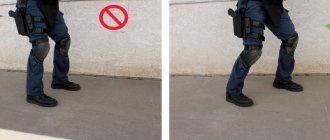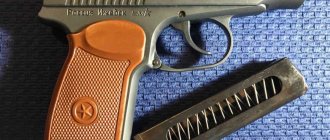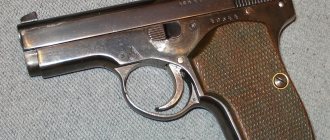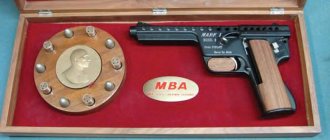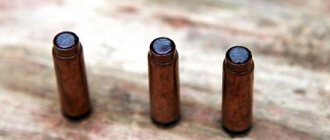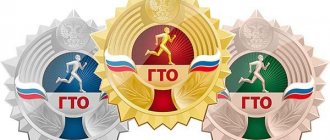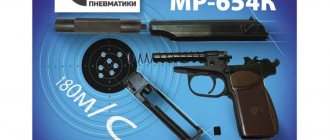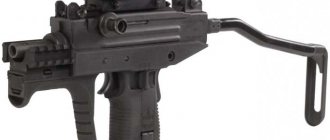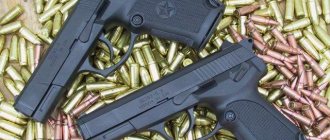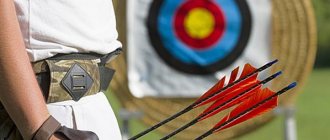Tactical technical characteristics of the 9-mm Makarov pistol (PM)
- Weight of pistol with magazine without cartridges 730 g
- Weight of the pistol with a magazine loaded with eight rounds: 810 g
- Pistol length 161 mm
- Gun height 126.75 mm
- Barrel length 93 mm
- Barrel caliber 9 mm
- Number of grooves 4
- Magazine capacity 8 rounds
- Cartridge weight 10 g
- Bullet weight 6.1 g
- Chuck length 25 mm
- combat rate of fire 30 rounds per minute
- Initial bullet speed 315 m/s
Safety
When shooting, you must adhere to basic safety measures:
- Persons who have not completed a training course in the use of weapons are not allowed to shoot. Any shooter must know safety precautions, rules for loading and unloading a pistol, as well as how to disassemble and reassemble it. In addition, you will need to study the design features of the weapon.
- The sound of a gun firing can deafen the user. In this regard, special headphones must be used in indoor shooting ranges. Before starting shooting, you must make sure that there are no strangers or animals within the next hundred meters.
- The clip must contain cartridges that match the type and caliber of the weapon. It is prohibited to use bullets that misfire or do not meet the technical parameters.
- A defective model is strictly prohibited from being used for shooting.
Pistol shooting
- Persons who have not completed a training course or are not familiar with the rules for operating a specific weapon are not allowed to fire a pistol. Every person firing from any pistol must know basic safety measures and be familiar with the rules for assembling and disassembling weapons and the operation of the main structural mechanism.
- When shots are fired at targets, strangers must not be allowed into the designated area. If a specific place is not specifically intended for shooting, then before using a weapon you should make sure that people and animals cannot pass within several hundred meters.
- The magazine may contain only those cartridges that are suitable for shooting in all respects. You cannot use cartridges that are taken from a batch where at least one copy misfired. Also prohibited are bullets that are not intended for the type of handgun that the user currently owns.
- It is prohibited to use a faulty pistol for shooting.
- If the fuse is turned off, it is necessary to ensure that the flag is lowered all the way down. If the flag is not fixed in any way, shooting is prohibited.
- It is impossible to cover the barrel with your hand or plug it with foreign objects, as it can become deformed and, under strong stress, explode.
- If there is a risk of sand or other significant contaminants entering the bore, it must be opened, carefully inspected and cleaned. If you don’t have time to do this, you just need to shake the weapon vigorously so that the excess contents spill out. An easy and quick way to clean the inside of the barrel: wiping with a rag attached to a cleaning rod.
- When reloading a weapon, the muzzle should be pointed in the direction where the person intends to shoot.
- Before carrying out a full inspection of the contents of the pistol structure, disassembling, cleaning and reassembling, as well as after finishing shooting, you should make it a rule to unload the weapon.
- If it is necessary to transfer the pistol from combat readiness to field conditions, you need to activate the safety and make sure it is reliable. If possible, the muzzle of the weapon is directed in the direction that is safest for the owner and the people around him.
- To avoid mechanical injury, you should control the position of your hands during shooting. Fingers should not get into the shutter rollback zone.
- The pistol should only be stored with the safety switch on in places that are safe and secure from children.
READ MORE: Cleansing enema: description of the procedure and rules for colon cleansing
How to shoot from a PM correctly?
Standard pistol kit
Before starting training, you need to purchase sufficient spare parts for the pistol. Watch a video review of air pistols here.
Needed:
- Holster.
- Spray can (for gas pistols).
- Shop.
- Muffler.
- Bullet holder.
- If you need quick access to the pistol (when storing it in a car or at home), purchase a pistol holder.
To develop shooting skills, many people choose a shooting range. However, it is not often possible to find a site that is optimally sized. It will be especially difficult for novice shooters who are distracted by other people or observers. Before using a weapon, even an air gun, read the operating instructions and relevant legislation.
Since, of course, it will not be possible to learn how to shoot from a PM at home, you will need to find a suitable place for this. A large clearing where there are no other citizens or animals is suitable as a shooting range. It is advisable to start shooting after thoroughly stretching your joints and muscles. Surprisingly, it will help strengthen and make your arms and body more stable.
To be able to hit the target accurately, you need to feel the operation and features of the weapon, as well as navigate the distance to the target. For the pistol in question, it leaves no more than 15 meters. Having mastered shooting and accuracy at this distance, you can try success at long range.
Selecting an aiming point
100. Shooting from a pistol is carried out from any place and from any position, ensuring the destruction of the target in the shortest possible time.
101. In battle, the place for firing a pistol is chosen by the shooter independently. When choosing a place for shooting, it is necessary to take into account the situation and the nature of the terrain.
102. The chosen place for shooting should provide the greatest degree of convenience of action, the greatest effectiveness of fire and cover or cover for enemy fire.
103. Targets for firing a pistol in battle are single enemy soldiers and officers located openly, suddenly appearing or moving.
104. When choosing a target, be guided by the meaning of the target, choosing the closest and most vulnerable.
105. To more reliably hit a target, take into account the distance to it and the amount of trajectory exceeded, guided by the table above.
106. When shooting at stationary targets at ranges up to 50 m, the aiming point is selected each time in accordance with the location of the target and its height.
107. Shoot at targets moving in the firing plane in the same way as at stationary targets.
To hit a target moving at an angle to the shooting plane, place the aiming point in the direction of the target’s movement, taking into account the speed of its movement.
108. Shoot at a target that appears for a short time or suddenly, conduct self-cocking and open fire offhand at the moment of the most advantageous position of the target.
Many people choose a shooting range to practice their skills. Rarely does one find the most convenient platform. A shooter, especially a beginner, will be constantly disturbed by strangers who either shoot themselves or watch the success of others. You can learn to shoot a pistol through courses or from a friend who has professional skills.
Many people are faced with the problem of weapon power; material on how to increase the power of an air pistol will help with this. Read about how to repair an air pistol here. When using a weapon, never forget about responsibility and the law on the use of firearms by the police.
Recommendations
Below are useful tips from instructors:
Additional devices
Modification PM-49 can be equipped with the following equipment:
- A night vision scope, which is needed to accurately hit the target in the absence of the necessary lighting or in the dark. The disadvantages of this device include low efficiency in dim lighting mode and at dawn. The device does not provide sufficient visibility in the glare of sunlight, when there is still not enough natural light. As a rule, such a sight makes it possible to see the clear outlines of a target within a few meters.
- Under-barrel flashlights of a tactical nature. They act as a bright and targeted designation, and are also an additional method of gentle defense. If you direct a stream of light into the enemy's eyes, the person loses his bearings for a while. The disadvantages of the element include the weight of the weapon.
- Adjusting the descent. It consists of adjusting the pistol hook or limiting its stroke. This modernization allows you to hit the target more accurately. In addition, the sequence of shots increases, and the movement of the trigger and safety is also easier. Such an improvement is required in exceptional cases.
- Shooting at a shooting range from combat weapons of the PM type is made easier by rubber pads on the sides of the handle. At the same time, the pistol becomes more convenient to hold. This is especially true for users with a wide hand grip. However, it is necessary to monitor these elements, checking their fixation and cleanliness.
Shooting instructor tips
- When conducting a battle, you must not let your ammunition run out completely. Get used to this at the learning stage. When the number of bullets comes to an end, reload the magazine.
- To ensure timely protection or surprise attack, practice snatching the weapon from the holster in one sharp movement and instantly prepare to fire.
- Even when shooting very quickly, try not to pull the trigger thoughtlessly, and if you need an instant response, check the accuracy and speed of use of the weapon.
- Shooting a pistol in public places unless absolutely necessary is prohibited. Only designated areas may be used for training.
- To learn to shoot a pistol accurately, you need to constantly practice. If you fail, you can reduce the distance from the goal. Upon successful completion of training, regular training is required.
READ MORE: Rules for selling used cars
Kneeling position
This type of shooting is carried out in the following stages:
- First, the left leg is brought behind the right limb. In this case, a clear straight line should form, the distance between the legs is approximately equal to the width of the shoulders.
- Then you need to squat down, bringing your right knee down. The heel of the right foot is used as support. Your feet should be straight and your toes pointed in the direction of the target.
- The pistol is taken out, the safety is removed, and a shot is fired.
This shooting position requires a lot of training, after which the shooter will be able to spring on bent legs, changing positions and direction of fire.
Shooting in low visibility conditions
109. When shooting at night under artificial lighting, great skill is required from the shooter to fire a shot in a short period of time. When lighting the area, the shooter must quickly find the target and fire offhand a shot or a series of shots, depending on the duration of the illumination.
Shooting at dusk and on a bright (moonlit) night should be carried out according to the same rules as during the day.
110. At night, when it is not possible to illuminate the target and take aim, fire offhand at silhouettes or in the direction of flashes of shots and various sounds coming from the enemy.
READ MORE: Japanese crosswords online: help, how to solve
111. Shooting under conditions of exposure to toxic and radioactive substances is carried out in personal protective equipment.
The rules for shooting at various targets are the same as for shooting under normal conditions.
Misfire
The most common type of delay when shooting is a misfire; even people unfamiliar with weapons know about it. The main sign of a misfire, in addition to the fact that the shot did not occur, is the shutter stopping in the rear position on the shutter delay. The cause of the misfire may be a malfunction of the cartridge, in which case the delay can be solved by a simple reload. Another reason is thickening of the lubricant or a dirty channel under the firing pin. In this case, when shooting, the problem cannot be solved; you need to thoroughly clean the weapon, remove carbon deposits, varnish and thickened grease.
Misfire can also be caused by a loose fuse lock. During the shot, the fuse is turned on, so there is a misfire. If the problem persists, the fuse or retainer must be replaced.
View gallery
